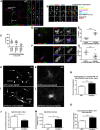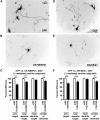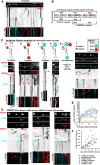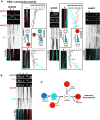Maturational conversion of dendritic early endosomes and their roles in L1-mediated axon growth
- PMID: 25355216
- PMCID: PMC4212064
- DOI: 10.1523/JNEUROSCI.1837-14.2014
Maturational conversion of dendritic early endosomes and their roles in L1-mediated axon growth
Abstract
The function of endosomes is intricately linked to cellular function in all cell types, including neurons. Intriguingly, neurons express cell type-specific proteins that localize to endosomes, but little is known about how these neuronal proteins interface with canonical endosomes and ubiquitously expressed endosomal components, such as EEA1 (Early Endosomal Antigen 1). NEEP21 (Neuronal Early Endosomal Protein 21 kDa) localizes to somatodendritic endosomes, and downregulation of NEEP21 perturbs the correct trafficking of multiple receptors, including glutamate receptors (GluA2) during LTP and amyloidogenic processing of βAPP. Our own work implicated NEEP21 in correct trafficking of the axonal cell adhesion molecule L1/neuron-glia cell adhesion molecule (NgCAM). NEEP21 dynamically localizes with EEA1-positive early endosomes but is also found in EEA1-negative endosomes. Live imaging reveals that NEEP21-positive, EEA1-negative endosomes arise as a consequence of maturational conversion of EEA1/NEEP21 double-positive endosomes. Interfering with EEA1 function causes missorting of L1/NgCAM, axon outgrowth defects on the L1 substrate, and disturbance of NEEP21 localization. Last, we uncover evidence that functional interference with NEEP21 reduces axon and dendrite growth of primary rat hippocampal neurons on L1 substrate but not on N-cadherin substrate, thus implicating endosomal trafficking through somatodendritic early endosomes in L1-mediated axon growth.
Keywords: NEEP21; NgCAM; Nsg-1; endosomes; live imaging; trafficking.
Copyright © 2014 the authors 0270-6474/14/3414633-11$15.00/0.
Figures




Similar articles
-
The somatodendritic endosomal regulator NEEP21 facilitates axonal targeting of L1/NgCAM.J Cell Biol. 2008 Feb 25;180(4):827-42. doi: 10.1083/jcb.200707143. J Cell Biol. 2008. PMID: 18299352 Free PMC article.
-
Neuronal early endosomes require EHD1 for L1/NgCAM trafficking.J Neurosci. 2010 Dec 8;30(49):16485-97. doi: 10.1523/JNEUROSCI.3127-10.2010. J Neurosci. 2010. PMID: 21147988 Free PMC article.
-
Alterations of EHD1/EHD4 protein levels interfere with L1/NgCAM endocytosis in neurons and disrupt axonal targeting.J Neurosci. 2010 May 12;30(19):6646-57. doi: 10.1523/JNEUROSCI.5428-09.2010. J Neurosci. 2010. PMID: 20463227 Free PMC article.
-
Endocytosis and endosomes at the crossroads of regulating trafficking of axon outgrowth-modifying receptors.Traffic. 2011 Sep;12(9):1099-108. doi: 10.1111/j.1600-0854.2011.01213.x. Epub 2011 May 23. Traffic. 2011. PMID: 21535338 Free PMC article. Review.
-
Complementary roles of the neuron-enriched endosomal proteins NEEP21 and calcyon in neuronal vesicle trafficking.J Neurochem. 2015 Jan;132(1):20-31. doi: 10.1111/jnc.12989. J Neurochem. 2015. PMID: 25376768 Review.
Cited by
-
Neuron-Specific Gene 2 (NSG2) Encodes an AMPA Receptor Interacting Protein That Modulates Excitatory Neurotransmission.eNeuro. 2019 Jan 24;6(1):ENEURO.0292-18.2018. doi: 10.1523/ENEURO.0292-18.2018. eCollection 2019 Jan-Feb. eNeuro. 2019. PMID: 30680309 Free PMC article.
-
Human platelet lysate stimulates neurotrophic properties of human adipose-derived stem cells better than Schwann cell-like cells.Stem Cell Res Ther. 2023 Jul 21;14(1):179. doi: 10.1186/s13287-023-03407-3. Stem Cell Res Ther. 2023. PMID: 37480149 Free PMC article.
-
The neurotrophin receptor signaling endosome: Where trafficking meets signaling.Dev Neurobiol. 2017 Apr;77(4):405-418. doi: 10.1002/dneu.22427. Epub 2017 Feb 24. Dev Neurobiol. 2017. PMID: 27503831 Free PMC article. Review.
-
Dynamics and distribution of endosomes and lysosomes in dendrites.Curr Opin Neurobiol. 2022 Jun;74:102537. doi: 10.1016/j.conb.2022.102537. Epub 2022 Apr 8. Curr Opin Neurobiol. 2022. PMID: 35398663 Free PMC article. Review.
-
Spatial regulation of endosomes in growing dendrites.Dev Biol. 2022 Jun;486:5-14. doi: 10.1016/j.ydbio.2022.03.004. Epub 2022 Mar 17. Dev Biol. 2022. PMID: 35306006 Free PMC article. Review.
References
-
- Hoogenraad CC, Popa I, Futai K, Martinez-Sanchez E, Wulf PS, van Vlijmen T, Dortland BR, Oorschot V, Govers R, Monti M, Heck AJ, Sheng M, Klumperman J, Rehmann H, Jaarsma D, Kapitein LC, van der Sluijs P. Neuron specific Rab4 effector GRASP-1 coordinates membrane specialization and maturation of recycling endosomes. PLoS Biol. 2010;8:e1000283. doi: 10.1371/journal.pbio.1000283. - DOI - PMC - PubMed
Publication types
MeSH terms
Substances
Grants and funding
LinkOut - more resources
Full Text Sources
Other Literature Sources
Research Materials
